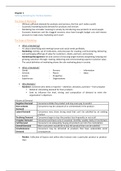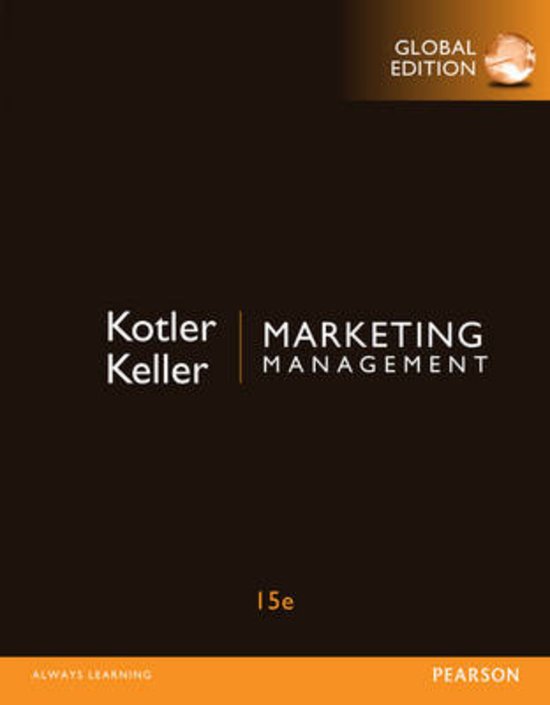Chapter 1
Defining Marketing for the New Realities
The Value of Marketing
- Without sufficient demand for products and services, the firm can’t make a profit
- Successful marketing builds demand for products and services
- Marketing has a broader meaning to society by introducing new products to assist people
- Economic downturn and the sluggish recovery since have brought budget cuts and intense
pressure to make every marketing cent count
The Scope of Marketing
Ø What is Marketing?
- It’s about identifying and meeting human and social needs profitably
- Marketing: Activity, set of institutions, and processes for creating, communicating, delivering
and exchanging offerings of value for customers, clients, partners, and society
- Marketing Management: Art and science of choosing target markets and getting, keeping and
growing customers through creating, delivering and communicating superior customer value
- The social definition of marketing shows the role marketing plays in society
Ø What is Marketed?
- Goods - Persons - Information
- Services - Places - Ideas
- Events - Properties
- Experiences - Organisations
Ø Who Markets?
- Marketer: Someone who seeks a response – attention, donation, purchase – from prospect
• Skilled at stimulating demand for their products
• Seek to influence the level, timing, and composition of demand to meet the
organisation’s objectives
8 States of Demand
Negative Demand Consumers dislike the product and may even pay to avoid it
Non-existent Consumers may be unaware of or uninterested in the product
Demand
Latent Demand Consumers may share strong need that can’t be satisfied by an existing
product
Declining Demand Consumers begin to buy the product less frequently or not at all
Irregular Demand Consumer purchases vary on seasonal, monthly, weekly, daily or hourly basis
Full Demand Consumers are adequately buying all products put into the marketplace
Overall Demand More consumers would like to buy the product than can be satisfied
Unwholesome Consumers may be attracted to products that have undesirable social
Demand consequences
- Market: Collection of buyers and sellers who transact over a particular product or product
class
, Resources Resources
Resource
Money Money
Markets
Taxes, Services,
Goods Money
Services,
Money Taxes
Manufacturer Government Consumer
Markets Markets Markets
Taxes, Goods Services
Services, Taxes,
Money Goods
Money Money
Goods & Services Intermediary Goods & Services
Markets
- Five basic markets are their connecting flows are shown above
• Manufacturers go to resource markets, buy resources and turn them into goods and
services, and sell finished products to intermediaries, who sell them to consumers
• Consumers sell their labour and receive money to pay for goods and services
• The government collects tax revenues to buy goods from resource, manufacturer and
intermediary markets and uses these goods and services to provide public services
- Market covers various groupings of customers
• Need markets (diet seeking)
• Product markets (shoe market)
• Demographic markets (Millennials)
• Geographic markets (Chinese market)
a) Key Customer Markets
- Consumer Markets: Companies selling mass consumer goods and services establish a strong
brand image by developing a superior product or service, ensuring its availability, and backing
it with engaging communications and reliable performance
- Business Markets: Companies selling business goods and services face well-informed
professional buyers skilled at evaluating competitive offerings
- Global Markets: Companies in the global marketplace navigate cultural, language, legal, and
political differences while deciding which countries to enter, how to enter, how to adapt
features to each country, how to set prices and how to communicate in different cultures
- Non-profit and Governmental Markets: Companies selling to non-profit organisations with
limited purchasing power such as churches, universities, charitable organisations, and
government agencies need to price carefully
, Core Marketing Concepts
Needs, Wants - Needs are basic human requirements (air, food, water, recreation, education, entertainment)
& Demands - Needs become wants when directed to specific objects that might satisfy the need
- Demands are wants for specific products backed by an ability to pay
- Companies must measure not only how many people want their product, but also how many are willing
and able to buy it
- Five types of needs:
• Stated needs (The customer wants an inexpensive car)
• Real needs (The customer wants a car whose operating cost, not initial price, is low)
• Unstated needs (The customer expects good service from the dealer)
• Delight needs (The customer would like the dealer to include an onboard GPS system)
• Secret needs (The customer wants friends to see him as a savvy consumer)
Target - Marketers identify distinct segments of buyers by identifying demographic, psychographic, and
Markets, behavioural differences between them
Positioning & - They then decide which segment(s) present the greatest opportunities
Segmentation - For each of the target markets, the firm develops a market offering that it positions in the target buyers’
minds as delivering some key benefits
Offerings & - The intangible value proposition is made physical by an offering, which can be a combination of
Brands products, services, information and experiences
• A brand is an offering from a known source
• All companies strive to build a brand image with as many strong, favourable and unique brand
associations as possible
Marketing - To reach a target market, marketer uses three kinds of marketing channels
Channels • Communication Channels: Deliver and receive messages from target buyers and include newspapers,
magazines, radio, TV, mail, telephone, billboards, posters, Internet, etc.
o Firms communicate through the look of their retail stores, websites, and other media
• Distribution Channels: Help display, sell or deliver the physical product or service to the buyer or user
o May be direct via internet or email, or indirect with distributors, wholesalers, agents, and
intermediaries
• Service Channels: Used to carry out transactions with potential buyers
o Includes warehouses, transport companies, banks, insurance companies
Paid, Earned - Paid media include TV, magazine, display ads, paid search and sponsorships – all of which allow
& Owned marketers to show their ad or brand for a fee
Media - Owned media are communication channels marketers actually own, like a company or brand brochure,
website, blog, Facebook page or Twitter account
- Earned media are streams in which consumers, the press, or other outsiders voluntarily communicate
something about the brand via word of mouth, buzz, or viral marketing methods
Impressions - Impressions: Occur when a consumer views a communication, and are a useful metric for tracking the
& scope or breadth of a communication’s reach that can also be compared across all communication
Engagement types, but they don’t provide any insight into the results of viewing the communication
- Engagement: Extent of a customers’ attention and active involvement with a communication; reflects
a much more active response than a mere impression and more likely to create value for the firm
Value and - The buyer chooses the offerings they perceive to deliver the most value
Satisfaction - Value is the sum of the tangible and intangible benefits and costs
- Customer value triad: Combination of quality, service, and price
• Value perceptions increase with quality and service, decrease with price
- Satisfaction is a person’s judgement of a product’s perceived performance in relation to expectations
• Performance < Expectation = Disappointed
• Performance = Expectation = Satisfied
• Performance > Expectation = Delighted
Competition Includes all the actual and potential rival offerings and substitutes a buyer might consider
Marketing Task Environment: Includes actors engaged in producing, distributing and promoting the offering
Environment • Suppliers, distributors, dealers, target customers
Broad Environment: Consists of the demographic-, economic-, socio-cultural-, natural-, technological, and
political-legal environments
• Marketers play close attention to the trends and developments in these and adjust their marketing
strategies as needed
, The New Marketing Realities
1. Technology
2. Globalisation
3. Social Responsibility
A Dramatically Changed Marketplace
1. New Consumer Capabilities
- Consumers can use the Internet as a powerful information and purchasing aid
• Compare product prices and features, consult user reviews, order online, bypass limited
local offerings
- Consumers can search, communicate and purchase on the move
- Consumers can tap into social media to share opinions and express loyalty
- Consumers can actively interact with companies
• Opt in or out of lists, they can receive marketing communications, discounts, coupons,
special deals
- Consumers can reject marketing they find inappropriate
2. New Company Capabilities
- Companies can use the Internet as a powerful information and sales channel, including for
individually differentiated goods
• Websites list products, services, history, business philosophy, job opportunities, and
other information to consumers worldwide
- Companies can collect fuller and richer information about markets, customers, prospects and
competitors
• Can conduct fresh marketing research by using the internet
- Companies can reach consumers quickly and efficiently via social media and mobile
marketing, sending targeted ads, coupons and information
• Location-based advertising • Social media and word-of-mouth
- Companies can improve purchasing, recruiting, training, and internal and external
communications
- Companies can improve their cost efficiency
3. Changing Channels
- One of the reasons consumers have more choices is that channels of distribution have
changed as a result of retail transformation and disintermediation
- Retail Transformation: Store-based retailers face competition from e-commerce; catalogue
houses; direct-mail firms; newspaper, TV, magazine and direct-to-customer ads
• In response, retailers are building entertainment into their stores with coffee bars,
demonstrations, and performances, marketing an “experience” rather than just
product assortments
- Disintermediation: Intervening in the traditional flow of goods
• In response, traditional companies engaged in reintermediation and became “brick-
and-click” retailers, adding online services to their offerings
4. Heightened Competition
- Private labels: Powerful retailers that market their own store brands
- Mega-brands: Strong brands have become MB and extended in related product categories,
including new opportunities at the intersection of two or more industries
- Deregulation: Many countries have deregulated industries to create greater competition and
growth opportunities
- Privatisation: Many countries have converted public companies to private ownership to
increase their efficiency






